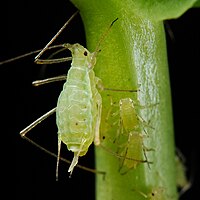
Photo from wikipedia
Simple Summary Resistance of a Pisum fulvum and five Pisum sativum genotypes to Acyrthosiphon pisum pea and alfalfa-adapted biotypes was evaluated by measuring aphid body mass, confirming the variable resistance… Click to show full abstract
Simple Summary Resistance of a Pisum fulvum and five Pisum sativum genotypes to Acyrthosiphon pisum pea and alfalfa-adapted biotypes was evaluated by measuring aphid body mass, confirming the variable resistance level of these genotypes. The feeding behavior of the aphids on the Pisum genotypes was then examined by electropenetrography (EPG). The EPG results suggested that the resistance of Pisum genotypes to non-adapted A. pisum resides in mesophyll and phloem tissues while the resistance variation of P. sativum to pea adapted aphids may be influenced by the quality of phloem sap. Abstract Resistant genotypes of crops have emerged as an alternative and sustainable solution to pesticide use against pest insects. The resistance depends on the genetic diversity of the host plant and the pest species and can cause an alteration of the insect behavior. The aim of this work was to characterize the resistance level of different Pisum genotypes (one P. fulvum and five P. sativum genotypes) to two biotypes of the aphid Acyrthosiphon pisum, respectively adapted to pea and alfalfa, by measuring the individual aphid weight and analyzing aphid feeding behavior by electropenetrography (EPG). Aphid body mass was influenced by Pisum genotypes reflecting variation in their resistance level. P. fulvum was the most resistant to the A. pisum pea biotype (ArPo28 clone) and showed intermediate resistance to the A. pisum alfalfa biotype (LSR1 clone). The resistance levels of the five P. sativum genotypes to the two aphid biotypes were variable and more pronounced for the alfalfa biotype. EPG data showed that ArPo28 on P. fulvum and LSR1 on all the Pisum genotypes spent shorter time phloem feeding compared to ArPo28 on P. sativum genotypes, indicating that the resistance of Pisum genotypes to non-adapted A. pisum resides in mesophyll and phloem cells. In the meantime, ArPo28 on P. sativum genotypes with a different level of resistance spent a similar length of time phloem feeding, indicating that the quality of phloem sap of the resistance genotypes may not be optimal for the aphid. The study indicated that the resistance of Pisum genotypes to the two A. pisum biotypes involves different genetic factors and mechanisms that affect the aphid differently.
Journal Title: Insects
Year Published: 2022
Link to full text (if available)
Share on Social Media: Sign Up to like & get
recommendations!